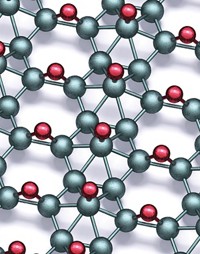Advertisement
Grab your lab coat. Let's get started
Welcome!
Welcome!
Create an account below to get 6 C&EN articles per month, receive newsletters and more - all free.
It seems this is your first time logging in online. Please enter the following information to continue.
As an ACS member you automatically get access to this site. All we need is few more details to create your reading experience.
Not you? Sign in with a different account.
Not you? Sign in with a different account.
ERROR 1
ERROR 1
ERROR 2
ERROR 2
ERROR 2
ERROR 2
ERROR 2
Password and Confirm password must match.
If you have an ACS member number, please enter it here so we can link this account to your membership. (optional)
ERROR 2
ACS values your privacy. By submitting your information, you are gaining access to C&EN and subscribing to our weekly newsletter. We use the information you provide to make your reading experience better, and we will never sell your data to third party members.
Materials
Carbon Atoms On The Go
Videos catch carbon atoms undergoing rearrangements along graphene edges
by Mitch Jacoby
April 1, 2009
Armed with a state-of-the-art microscope, researchers in California have recorded the first videos that capture the dynamics of individual carbon atoms in a sheet of graphene—a one-atom-thick layer of carbon hexagons (Science 2009, 323, 1705).

The videos, which catch numerous atoms hopping to and fro as they make and break chemical bonds along the edge of a hole in the sheet, reveal the types of atomic arrangements that are stable near such defects and the mechanisms by which the defects evolve. The study broadens basic understanding of one-atom-thick two-dimensional crystals and may hasten development of electronic devices built from these materials.
Not long after scientists demonstrated that one-atom-thick films of graphene can be isolated and are stable at room temperature, researchers in many labs found that this thinnest of all carbon materials is endowed with outstanding electronic, structural, and other properties. Those findings, made within the past few years, led to today's widespread effort to develop graphene-based applications in display technology, computing, and other areas (C&EN, March 2, page 14).
As with carbon nanotubes and other nanoscale materials, graphene's electronic properties are predicted by theoreticians to be shaped by the structure of the material's edges. Yet, few methods exist for studying those edges directly.
Now, a team of physicists at the University of California, Berkeley, has used an advanced ("aberration corrected") transmission electron microscope (TEM) to follow in real time the rearrangements of atoms along the edge of a hole punched into a film of graphene. The hole was made by ejecting carbon atoms via prolonged exposure to the TEM's high-energy electron beam. As the hole continues to grow under the influence of the beam, carbon atoms near the hole scramble to fill vacancies and find stable bonding configurations.
According to the team, which includes ?a?lar Ö. Girit, Jannik C. Meyer, Alex Zettl, and coworkers, one edge configuration, which they dub "zigzag," stands out as the most stable arrangement. In that arrangement, the apexes of the carbon hexagons define a straight line, which minimizes the atomic corrugation (bumpiness) along the edge of the hole. In contrast, arrangements that lead to greater corrugation are less stable, the team reports.
"Atoms that lose their neighbors become highly volatile and move around rapidly, continually repositioning themselves from one metastable configuration to the next," Zettl says. "Although configurations come and go, we found the zigzag configuration to be the most stable."
By considering the energy required for atom removal, the number of remaining nearest neighbors, vacancy-filling (or "film repair") events, and other factors, the researchers developed a model that describes the atom ejection and hole-growth processes. Then they used the model to produce a simulated TEM video, which reproduces many of the experimental observations.
"This is a beautiful study that could help chemists design site-selective reactions to functionalize carbon atoms along edges in various configurations," Northwestern University materials science professor Jiaxing Huang says. "I hope this work will inspire scientists to come up with a healing process to eliminate defects in graphene, which would be very exciting for applications in electronics."





Join the conversation
Contact the reporter
Submit a Letter to the Editor for publication
Engage with us on Twitter